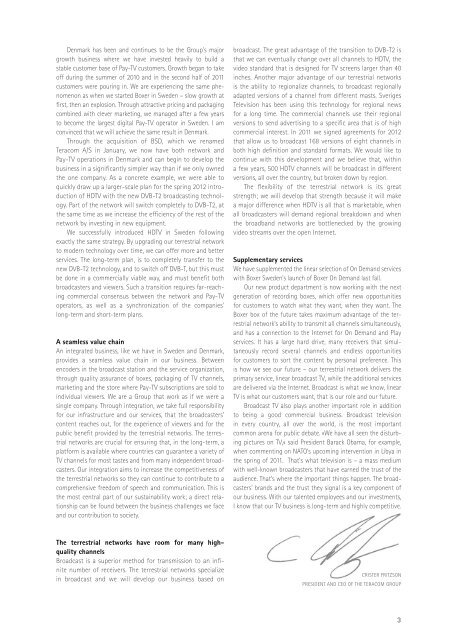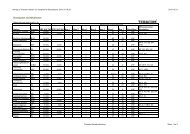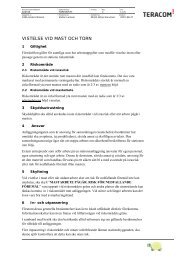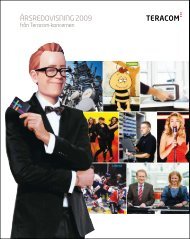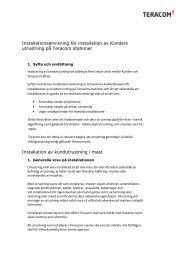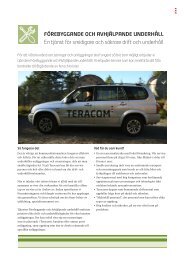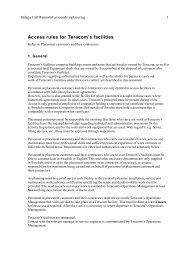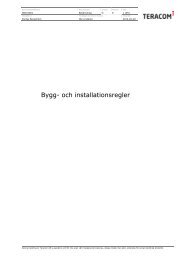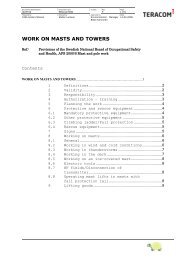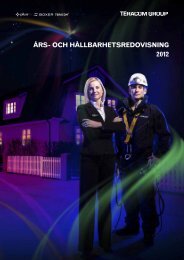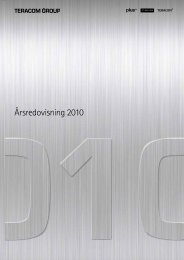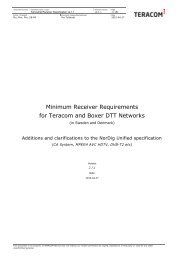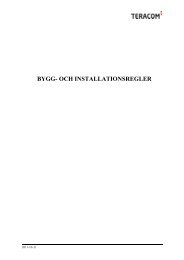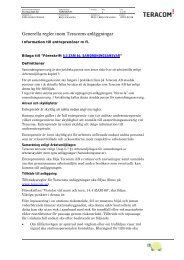Annual and Sustainability Report 2011 - Teracom
Annual and Sustainability Report 2011 - Teracom
Annual and Sustainability Report 2011 - Teracom
Create successful ePaper yourself
Turn your PDF publications into a flip-book with our unique Google optimized e-Paper software.
Denmark has been <strong>and</strong> continues to be the Group's major<br />
growth business where we have invested heavily to build a<br />
stable customer base of Pay-TV customers. Growth began to take<br />
off during the summer of 2010 <strong>and</strong> in the second half of <strong>2011</strong><br />
customers were pouring in. We are experiencing the same phenomenon<br />
as when we started Boxer in Sweden – slow growth at<br />
first, then an explosion. Through attractive pricing <strong>and</strong> packaging<br />
combined with clever marketing, we managed after a few years<br />
to become the largest digital Pay-TV operator in Sweden. I am<br />
convinced that we will achieve the same result in Denmark.<br />
Through the acquisition of BSD, which we renamed<br />
<strong>Teracom</strong> A/S in January, we now have both network <strong>and</strong><br />
Pay-TV operations in Denmark <strong>and</strong> can begin to develop the<br />
business in a significantly simpler way than if we only owned<br />
the one company. As a concrete example, we were able to<br />
quickly draw up a larger-scale plan for the spring 2012 introduction<br />
of HDTV with the new DVB-T2 broadcasting technology.<br />
Part of the network will switch completely to DVB-T2, at<br />
the same time as we increase the efficiency of the rest of the<br />
network by investing in new equipment.<br />
We successfully introduced HDTV in Sweden following<br />
exactly the same strategy. By upgrading our terrestrial network<br />
to modern technology over time, we can offer more <strong>and</strong> better<br />
services. The long-term plan, is to completely transfer to the<br />
new DVB-T2 technology, <strong>and</strong> to switch off DVB-T, but this must<br />
be done in a commercially viable way, <strong>and</strong> must benefit both<br />
broadcasters <strong>and</strong> viewers. Such a transition requires far-reaching<br />
commercial consensus between the network <strong>and</strong> Pay-TV<br />
operators, as well as a synchronization of the companies'<br />
long-term <strong>and</strong> short-term plans.<br />
A seamless value chain<br />
An integrated business, like we have in Sweden <strong>and</strong> Denmark,<br />
provides a seamless value chain in our business. Between<br />
encoders in the broadcast station <strong>and</strong> the service organization,<br />
through quality assurance of boxes, packaging of TV channels,<br />
marketing <strong>and</strong> the store where Pay-TV subscriptions are sold to<br />
individual viewers. We are a Group that work as if we were a<br />
single company. Through integration, we take full responsibility<br />
for our infrastructure <strong>and</strong> our services, that the broadcasters’<br />
content reaches out, for the experience of viewers <strong>and</strong> for the<br />
public benefit provided by the terrestrial networks. The terrestrial<br />
networks are crucial for ensuring that, in the long-term, a<br />
platform is available where countries can guarantee a variety of<br />
TV channels for most tastes <strong>and</strong> from many independent broadcasters.<br />
Our integration aims to increase the competitiveness of<br />
the terrestrial networks so they can continue to contribute to a<br />
comprehensive freedom of speech <strong>and</strong> communication. This is<br />
the most central part of our sustainability work; a direct relationship<br />
can be found between the business challenges we face<br />
<strong>and</strong> our contribution to society.<br />
broadcast. The great advantage of the transition to DVB-T2 is<br />
that we can eventually change over all channels to HDTV, the<br />
video st<strong>and</strong>ard that is designed for TV screens larger than 40<br />
inches. Another major advantage of our terrestrial networks<br />
is the ability to regionalize channels, to broadcast regionally<br />
adapted versions of a channel from different masts. Sveriges<br />
Television has been using this technology for regional news<br />
for a long time. The commercial channels use their regional<br />
versions to send advertising to a specific area that is of high<br />
commercial interest. In <strong>2011</strong> we signed agreements for 2012<br />
that allow us to broadcast 168 versions of eight channels in<br />
both high definition <strong>and</strong> st<strong>and</strong>ard formats. We would like to<br />
continue with this development <strong>and</strong> we believe that, within<br />
a few years, 500 HDTV channels will be broadcast in different<br />
versions, all over the country, but broken down by region.<br />
The flexibility of the terrestrial network is its great<br />
strength; we will develop that strength because it will make<br />
a major difference when HDTV is all that is marketable, when<br />
all broadcasters will dem<strong>and</strong> regional breakdown <strong>and</strong> when<br />
the broadb<strong>and</strong> networks are bottlenecked by the growing<br />
video streams over the open Internet.<br />
Supplementary services<br />
We have supplemented the linear selection of On Dem<strong>and</strong> services<br />
with Boxer Sweden's launch of Boxer On Dem<strong>and</strong> last fall.<br />
Our new product department is now working with the next<br />
generation of recording boxes, which offer new opportunities<br />
for customers to watch what they want, when they want. The<br />
Boxer box of the future takes maximum advantage of the terrestrial<br />
network’s ability to transmit all channels simultaneously,<br />
<strong>and</strong> has a connection to the Internet for On Dem<strong>and</strong> <strong>and</strong> Play<br />
services. It has a large hard drive, many receivers that simultaneously<br />
record several channels <strong>and</strong> endless opportunities<br />
for customers to sort the content by personal preference. This<br />
is how we see our future – our terrestrial network delivers the<br />
primary service, linear broadcast TV, while the additional services<br />
are delivered via the Internet. Broadcast is what we know, linear<br />
TV is what our customers want, that is our role <strong>and</strong> our future.<br />
Broadcast TV also plays another important role in addition<br />
to being a good commercial business. Broadcast television<br />
in every country, all over the world, is the most important<br />
common arena for public debate. »We have all seen the disturbing<br />
pictures on TV,« said President Barack Obama, for example,<br />
when commenting on NATO’s upcoming intervention in Libya in<br />
the spring of <strong>2011</strong>. That's what television is – a mass medium<br />
with well-known broadcasters that have earned the trust of the<br />
audience. That’s where the important things happen. The broadcasters’<br />
br<strong>and</strong>s <strong>and</strong> the trust they signal is a key component of<br />
our business. With our talented employees <strong>and</strong> our investments,<br />
I know that our TV business is long-term <strong>and</strong> highly competitive.<br />
The terrestrial networks have room for many highquality<br />
channels<br />
Broadcast is a superior method for transmission to an infinite<br />
number of receivers. The terrestrial networks specialize<br />
in broadcast <strong>and</strong> we will develop our business based on<br />
CRISTER Fritzson<br />
President <strong>and</strong> CEO of the <strong>Teracom</strong> Group<br />
3


